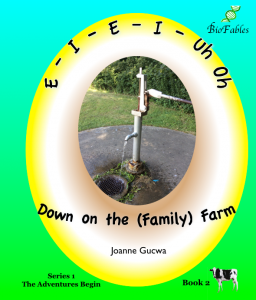 With a moo moo here, And a moo moo there, Here a moo, there a moo, Everywhere a moo moo. “Mom, will there be cows and pigs and chickens on the farm?” Home gardening isn’t quite as interesting to
With a moo moo here, And a moo moo there, Here a moo, there a moo, Everywhere a moo moo. “Mom, will there be cows and pigs and chickens on the farm?” Home gardening isn’t quite as interesting to Melody as the anticipation of getting up close and personal to cows and chickens and pigs. Her seven-year-old twin brother feels the same way. Waiting patiently for seeds to become yummy vegetables is not part of Mallory’s nature, and even waiting for lettuce seedlings to grow into salad material is too long. Better to dream about an adventure that’s only a week away. With an oink oink here, and an oink oink there, Here an oink…
Melody as the anticipation of getting up close and personal to cows and chickens and pigs. Her seven-year-old twin brother feels the same way. Waiting patiently for seeds to become yummy vegetables is not part of Mallory’s nature, and even waiting for lettuce seedlings to grow into salad material is too long. Better to dream about an adventure that’s only a week away. With an oink oink here, and an oink oink there, Here an oink…
BioFables children’s books focus on illuminating Sciences (STEM: Science, Technology, Engineering, Math) principles through fun stories. Parents, you know from experiencethat learning the subject matter that we call Sciences is a good first step. Understanding Humanities subjects helps us know how best to apply Sciences principles to the practical needs of the external world. And understanding one’s internal Values/Behaviors helps us to make things happen.
Every BioFables book weaves lessons derived from these interconnected (and often hidden) core disciplines into realistic stories that children relate to. Parents, you can use the free resources of this site to uncover those nearly-invisible lessons. They will help you prepare your children for happy, productive, rewarding and well-balanced lives.
If yyou’re ready to purchase E-I-E-I-Uh Oh, please click on the Buy E-I-E-I-Uh Oh icon to go directly to Barnes and Nobles’ E-I-E-I-Uh Oh page. Your purchase of E-I-E-I-Uh Oh helps support our ongoing efforts to continue expanding the wealth of this site’s resources for homeschooling and all parents who are dedicated to the intellectual growth of their children.
If you’d like to learn more about using the considerable E-I-E-I-Uh Oh resources at this site, please read on.
E-I-E-I Uh Oh Resources
The ten chapters in E-I-E-I-Uh Oh contain nearly a hundred practical mini-lessons and pop-up lessons woven throughout E-I-E-I-Uh Oh. We call these practical lessons Knowledge Nuggets. These Knowledge Nuggets contain specific information that readers can apply to their everyday lives. They may be in the form of a mini-lesson, with simple explanations of a specific concept, or as a quick, unplanned pop-up lesson.
You will find that many of these Knowledge Nugget lessons are in stealth mode. This is true especially in the Humanities and Values/Behaviors Core Disciplines, where common family experiences in E-I-E-I-Uh Oh offer lessons that might easily be missed.
Four sets of tables and lists in the E-I-E-I-Uh Oh Knowledge Gateways page help you to place a given Knowledge Nugget within the greater realm of learning.
-
- Chapter-by-Chapter: Sciences, Humanities, Values/Behaviors
- Entire E-I-E-I-Uh Oh: Sciences topics
- Entire E-I-E-I-Uh Oh: Humanities topics
- Entire E-I-E-I-Uh Oh: Values/Behaviors topics
Please visit Site Tips for even more ways to mine the wealth of information available on this site.

